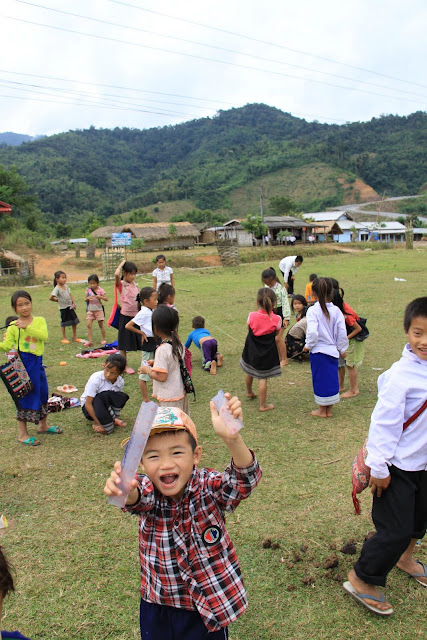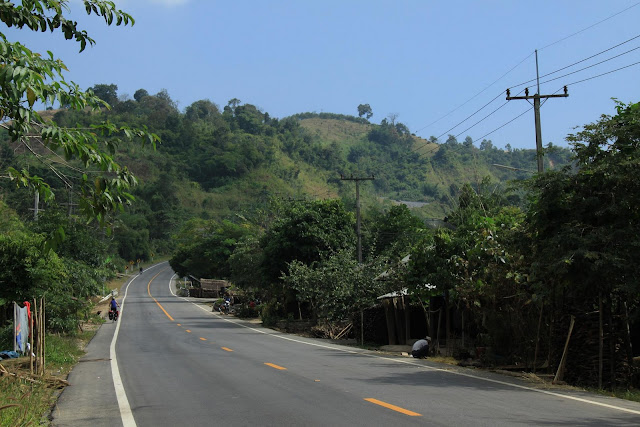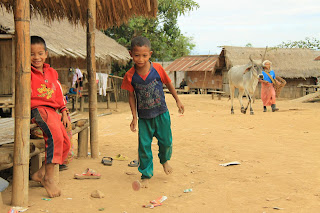Arrivés par bateau à Houaxay, nous décidons de rejoindre la ville de Louang Nahmta, dans les montagnes du nord du pays. Apres seulement quelques kilomètres, nous nous rendons vite compte de la différence avec la Thaïlande. La transition est frappante. Bien que les paysages soient similaires, les maisons sont beaucoup plus modestes, bien souvent sans électricité. Les routes sont, pour la plupart, en mauvais état ou en construction et étrangement désertes. Seuls de gros camions thaïlandais se croisent dans la poussière pour faire la navette jusqu’en Chine.
So we have made it to Laos, and I can only say what a start!
The border crossing from Thailand was actually pretty easy. We had our own little boat and the guy even helped us with our bikes. We already had our Visas in advance so all went pretty smoothly.
The cycling started pretty easy, back on the “normal” side of the road and much lighter traffic than in Thailand. The only thing to watch out is the trucks.
The cycling started pretty easy, back on the “normal” side of the road and much lighter traffic than in Thailand. The only thing to watch out is the trucks.
Mais le plus étonnant reste la réaction des enfants a notre passage. A chaque village, ils s’empressent de nous saluer de plusieurs « SABAI DEE » (Bonjour) et certains s’amusent même parfois à nous défier à vélo ou en courant quelques mètres à nos côtés.
We quickly realized that everything is much poorer over here and that there seem to be very few tourists passing the small villages. In every single village the children are running after us shouting ‘Sabai Dee”, wave and run after us. At our first lunch we noticed that we really were the attraction when a circle of adults and children formed around us watching us eat. This is quite something to get used to!
Le premier jour, la nuit tombant, nous n’avons pas d’autres choix que de nous arrêter au village de Naluang. Aucune trace de guesthouse parmi les cabanes en bois... Juste un petit commerce ou les gens s’amassent lorsque nous nous arrêtons pour acheter des pâtes et un peu d’essence pour le réchaud. Nous rencontrons par chance un jeune homme avec quelques bases d Anglais. Il nous propose de loger dans l’école du village, ce que nous acceptons avec plaisir. Nous souperons sous les yeux médusés de quelques villageois avant de passer notre première nuit entre les bancs de l’école...
We soon were in the mountains which are much less populated than the north of Thailand, making it difficult to find eating and sleeping opportunities. So when it slowly started to get dark we decided to call it a day in a small village we came pass as we had no idea how far the next one would be. There was no guesthouse and now restaurant around but we were lucky and go the offer to spend the night on the floor of the local primary school. In the local shop we managed to get some noodles and some petrol so we even managed to cook us a warm meal in company of the local children. We piled on all our clothes we have with us as the nights here get pretty chilly!


Quelques jours plus tard, nous stoppons à Viengphukha pour y faire un trek de 3 jours avec une agence d’éco-tourisme, reversant 40 % de l’argent aux villages visites. Accompagnés d’un guide, de son assistant et d’une touriste tchèque, nous démarrons au petit matin par un longue montée dans la foret ou nous croisons un petit groupe de villageois préparant la soupe pour les porteurs de riz. Nous en croiserons plusieurs par la suite, hommes et femmes, portant chacun un sac d’une quarantaine de kilos.
After some not so easy riding (we managed to get soaked one day and crossed our first 1000m mountain) we finally arrived in Viengphouka where we had planned to do some trekking. We signed up for a three day trek through the Long Nam Ha National Park and to some local villages.
On the trek there were just the two of us and a really nice czech girl from England, Martina. We were accompanied by a local guide who spoke good English and a guide assistant. The first day walking was fairly long with 7 hours heading up and down in the jungle, the following days were a bit easier. The bamboo forest was in particular impressive and some of the views were stunning.
Le lendemain, nous resterons dans un village beaucoup plus grand, regroupant deux communautés Hmong et Lao, d’environ 350 personnes. La soirée sera l’occasion pour nous de tester quelques pas de danses dans la salle du village, sans grand succès…
Apres un copieux repas étalé sur quelques feuilles de bananier et quelques verres de whisky de riz, nous atteignions notre premier camp de base en fin de journée : un village Hmong regroupant 3 familles, dont une qui nous hébergera. Pas d’école, encore moins de pharmacies pour ces communautés coupées du monde. Les enfants jouent à une version de toupies en bois, seule véritable occupation parmi les veaux, poules et autres porcs entourant les maisons. Nous dormirons sur une paillasse de bambou, juste a côté de la famille s’étant regroupée à proximité du feu.
During the Trek we shared the house with local families. Particularly the first night was pretty surreal. The village consisted of three houses, completely remote and cut off from the outside world. There must have been at least nine children sleeping in the same space as us and sometimes we were not sure if the noises came from them, the pigs, the chicken or any of the other animals trying to get into the interior.
Le lendemain, nous resterons dans un village beaucoup plus grand, regroupant deux communautés Hmong et Lao, d’environ 350 personnes. La soirée sera l’occasion pour nous de tester quelques pas de danses dans la salle du village, sans grand succès…
The second village was already much more developed and closer to the “city”. Our meals were still cooked on an open fire but there was a school and people had scooters and phones. In the evening we gathered with the village people around an open fire to warm ourselves and Martina and I joined the young girls practicing their dancing. However, they did not appreciate it when we tried to teach them the Moon walk or yellow submarine moves!
We have now hit the road again and are currently in Luang Namtha, a touristy city know for its trekking opportunities. Having done a trek already, we will carry on our journey further east to Oudoumxay and Khoa in order to get the the River Ou where we have planned to take a boat southwards.




























































